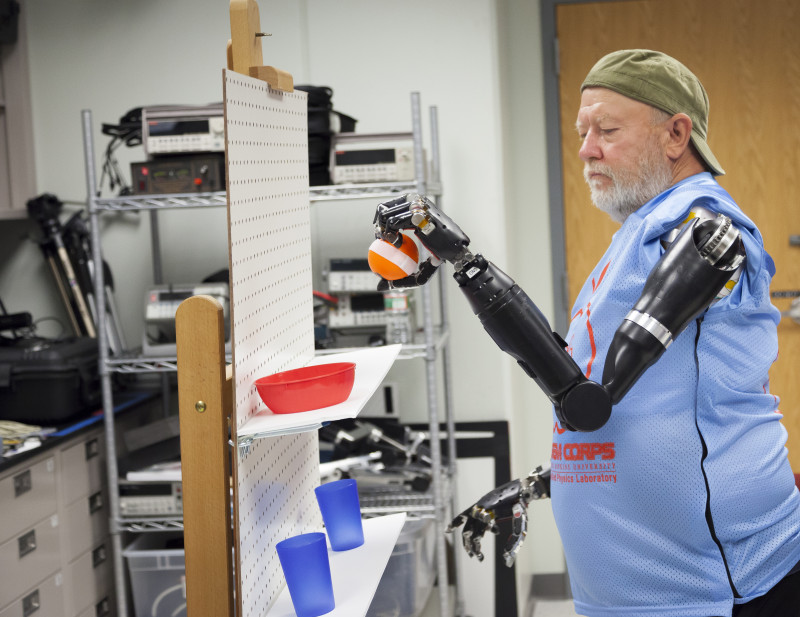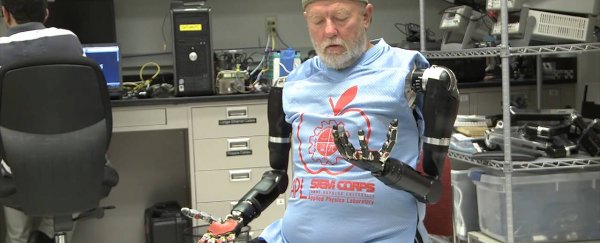
A double amputee in the US has made history by controlling two prosthetic arms at the same time with his thoughts.
Leslie Baugh lost both his arms in an electrical accident 40 years ago, but has now been able to control two prosthetics designed by the John Hopkins University Applied Physics Laboratory and use them to perform a variety of tasks, as you can see in the video above.
By simply thinking about the tasks, Baugh was able to move several objects, including an empty cup, from a counter to a higher shelf - an activity that required him to control eight separate motions at once.
The prosthetic devices are known as Modular Prosthetic Limbs (MPL) and they work in conjunction with a surgery known as targeted muscle reinnervation.
"It's a relatively new surgical procedure that reassigns nerves that once controlled the arm and the hand," said John Hopkins trauma surgeon Albert Chi in a press release.
"By reassigning existing nerves, we can make it possible for people who have had upper-arm amputations to control their prosthetic devices by merely thinking about the action they want to perform."
After the surgery, the researchers worked with Baugh on their pattern recognition system, which helps the scientists essentially calibrate the devices and program which signals the prosthetic limbs should respond to.
"We use pattern recognition algorithms to identify individual muscles that are contracting, how well they communicate with each other, and their amplitude and frequency," said Chi in the release. "We take that information and translate that into actual movements within a prosthetic."
Once they'd measured the patterns of Baugh's muscle contractions, they then fitted him with a custom socket that connects the prosthetic limb directly into his reinnervated arm nerves.
After training using a virtual reality version of the devices, he was finally fitted with the MPLs.
"I just went into a whole different world," Baugh said in the video above.
"This task simulated activities that may commonly be faced in a day-to-day environment at home," said Courtney Moran, a prosthetist working with Baugh. "This was significant because this is not possible with currently available prostheses. He was able to do this with only 10 days of training, which demonstrates the intuitive nature of the control."
 Johns Hopkins University Applied Physics Laboratory
Johns Hopkins University Applied Physics Laboratory
It's been a huge year for prosthetics, with scientists developing a new, flexible prosthetic skin that can sense temperature, pressure and moisture, earlier this month. In October a Swedish man also became the first person to be fitted with a mind-controlled prosthetic arm. And just this week a woman was able to use her thoughts to control a robot arm to grab and move objects.
The principal investigator on the project, Michael McLoughlin, believes we're going to see even more breakthroughs in the future. "I think we are just getting started. It's like the early days of the Internet. There is just a tremendous amount of potential ahead of us, and we've just started down this road. And I think the next five to 10 years are going to bring phenomenal advancement," he said in the release.
The next step will be for Baugh to go home with his new limbs and see how well they work in the outside world. It's something he's extremely excited about.
"Maybe for once I'll be able to put change in the pop machine and get pop out of it," he said. He's looking forward to doing "simple things that most people don't think of. And it's re-available to me."
Source: ScienceDaily
